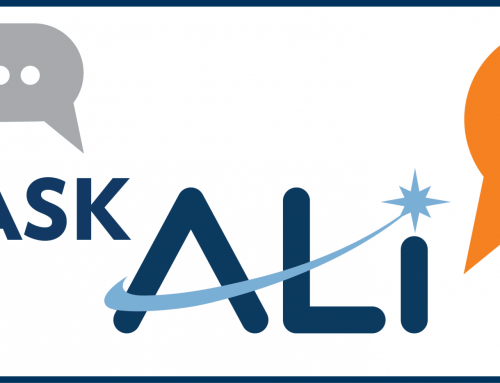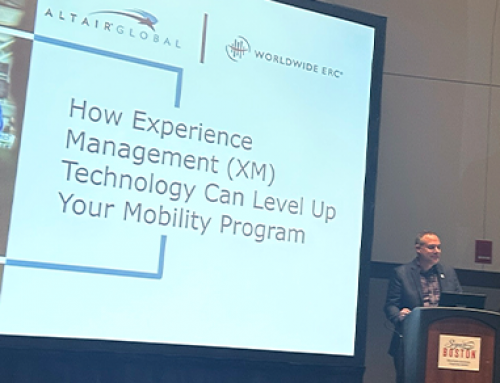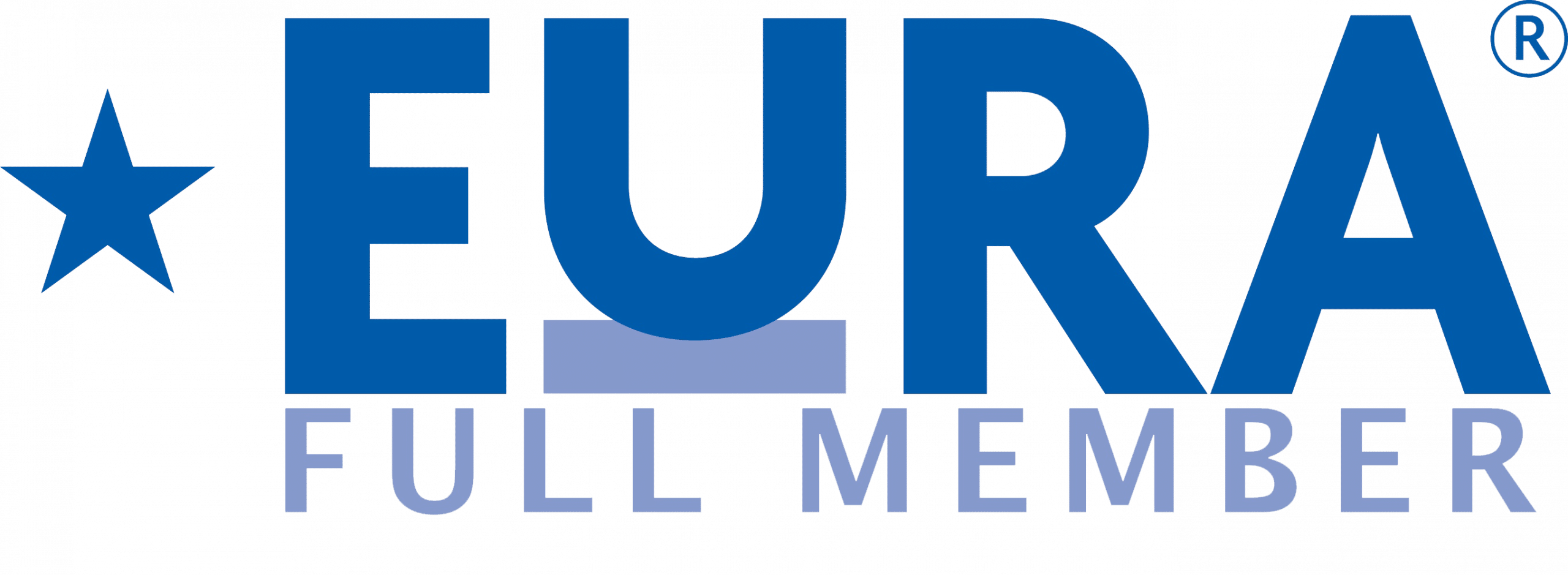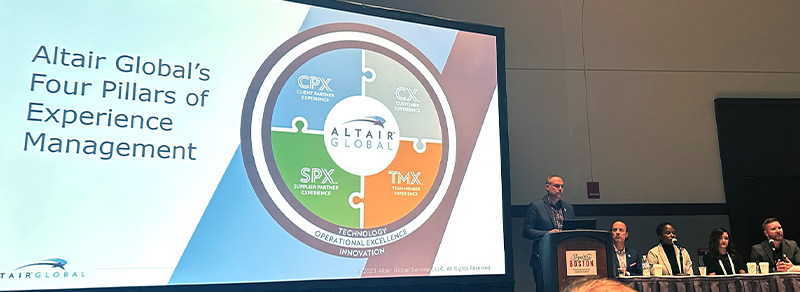
Navigating the Future of Experience Management (XM): Q&A with Our WERC GWS 2023 Panelists
Altair Global’s Brian Potts and Matthew Eschrich, along with Qualtrics’ Kelechi Anyanwu, answer audience questions from our experience Management (XM) panel at WERC GWS 2023.
Altair Global held a captivating, interactive XM panel during WERC GWS 2023 in Boston, featuring the following moderator and panelists:
- Brian Potts, EVP of the Americas at Altair Global
- Matthew Eschrich, VP of Client Services at Altair Global
- Kelechi Anyanwu, Regional Head of Solution Strategy, Customer Experience at Qualtrics
- Tricia Sirois, Senior Manager of Global Mobility at Adobe
- Rob Burns, Owner & CEO at IOR Global Services
In this hour-long, max capacity/standing-room-only session, audience members were encouraged to participate in poll surveys live and submit questions to be addressed by the panelists at the end of the session.
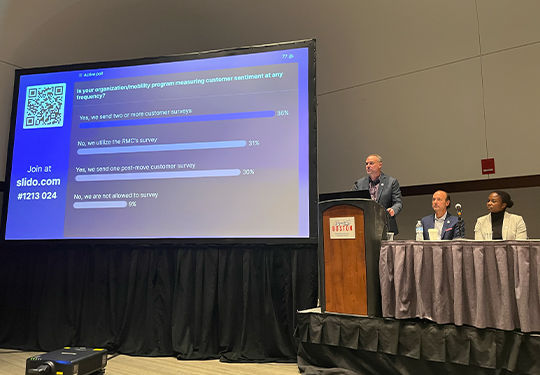
The audience came ready with insightful questions on building XM effectively into one’s mobility program. As happens with a session so jam-packed with knowledge and insights, the panel was only able to get through two questions before needing to conclude.
However, thanks to modern technology, we were not only able to give the audience a way to actively participate and ask questions digitally as they arose throughout the session, but also provided our panelists the opportunity to review all questions later that were unable to be addressed live. Here, Brian, Matthew, and Kelechi provide insight and perspectives to these audience questions.
Exploring the Synergy of AI and XM
As with almost every session that took place at WERC GWS 2023, the topic of AI was top of mind in our panel, with an audience member wondering how AI would fit into the XM framework.
Kelechi delved into the pivotal role of AI in shaping the future of XM. She shared, “AI is not new for Qualtrics–we’ve been doing this for a long time. Building on years of fine-tuned language models, Qualtrics has been training our platform with what we believe is the largest collection of human experience data on the planet.”
She highlighted the tangible impacts of AI on Qualtrics’ XM Platform, citing machine learning and deep learning as driving technologies. She explained, “AI’s significant impact is already noticeable in the innovations on Qualtrics’ XM Platform.” Notably, AI contributes to summarization, interactive analysis, and semantic search, fostering a culture of action and elevating both customer and employee experiences.
“61% of CX leaders recognize the competitive advantage of integrating AI into customer experiences.”
— Kelechi Anyanwu, Regional Head of Solution Strategy, Customer Experience at Qualtrics
In an industry where 61% of CX leaders recognize the competitive advantage of integrating AI into customer experiences, Kelechi emphasized Qualtrics’ commitment to further invest $500 million in AI innovation over the next four years. This strategic investment underscores Qualtrics’ dedication to delivering value while prioritizing privacy, security, and compliance.
Matthew advised that companies should keep in mind that AI is not a replacement for human talent, but rather a support tool. It’s not going to replace humans, but humans who use AI will eventually replace humans who don’t use AI.
He said that AI and XM could have places within relocation such as looking at XM insight trends through real-time customer pulses (what Altair calls X-checks). For example, one could start looking at programs and processes, like temporary living – if we start to see the same type of property, we can see 9 times out of 10 this type of property has a positive X-check. If we find a certain theme of people who move with pets, perhaps from a certain country, we can use AI to extrapolate that data faster and start solutioning toward the next move.
For a deeper understanding of how AI transforms XM, explore the details on Qualtrics’ website here.
Be Organic in Getting Feedback
One of the most typical quandaries for any company focused on customer feedback was asked in this session: how do you drive response rate?
Matthew shared that the simple answer is that there has to be a partnership between the supplier and the corporate client, and it needs to be organic – no coercion for a customer to answer the survey because what we’re looking for is honest feedback in the moment.
He continued that one tactic he’s seen work is clients adding the importance of the survey to their policies, within the relocation offer letter, and during the mobility consultation – it says a lot for the employer to say “Here, we want your feedback,” and then Altair comes in and supports that message.
As a final piece of advice, Matthew shared that you can make the survey or feedback omnichannel; Don’t only offer the direct pulse survey, also have a feedback channel on your website. On a similar thread, during the session the panelists delved into the need for listening at scale to give customers the opportunity to respond in the channels they prefer – from email to web to social media. Read more about that here.
Survey Timing and Content Come Down to a Partnership Approach
An audience member posed the question of how can supplier partners and RMCs work better together when RMCs often manage the timing and content of surveys, putting supplier partners at the mercy of their choices.
Brian shared that the XM approach has significantly helped this delicate dance of content and timing, making it clear who’s up first. This allows the RMC to distribute the pulse checks and surveys, and then disseminate the information back to suppliers. Before XM, he recalled that RMCs and suppliers were tripping over each other.
Matthew likened this to a true partnership approach. He advises companies to share when you’re building a customer experience (CX) journey map and where you’re building the pulse surveys for the customers into that. Companies should also go to market and let suppliers know that this is coming so that they’re not blindsided. He shared that it comes down to better communication on the process, expectation setting, and a complete harnessing of what the RMC partner can do and what the supplier partner can do.
Beyond Surveys: Unveiling Omnichannel Feedback Strategies
Addressing a question about the best ways to capture feedback and measure CX beyond surveys, it’s important to point out the evolving landscape of customer journeys and the limitations of traditional survey methods. Kelechi said, “Today’s customer journey is complex, with interactions happening before, during, and after a relocation (or purchase, event, etc.). Perceptions are formed at every stage. Organizations who want to understand the holistic customer experience need to go beyond surveys.”
Kelechi shared an on-demand webinar from Qualtrics featuring industry thought leaders Bruce Temkin, the “Godfather of Customer Experience,”and Rich Saunders, Senior Analyst at Forrester. The webinar explains how organizations need to extend beyond surveys and leverage omnichannel feedback for a holistic understanding of customer experiences, while also sharing insights into optimizing survey programs, making a business case for omnichannel listening, and strategies to win customer loyalty through a mature CX program.
Building a Business Case for Experience Management Technology
The next question from the audience delved into the challenge of building an investment case for experience management technology when a company is comfortable with traditional approaches.
Kelechi acknowledged this common hurdle and suggested a solution and helpful tool – an on-demand webinar from Qualtrics titled “The ROI of Customer Experience.” This webinar uncovers the critical key performance indicators and tools CX professionals should deploy to showcase the value of customer experience initiatives. It aims to empower professionals with strategies to establish a robust business case, track essential metrics, and secure companywide buy-in.
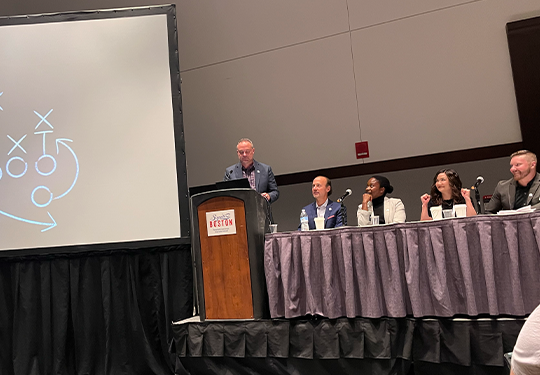
Unlocking Relocation Success: The Power of Pre-Relocation Surveys
In response to a query about advise on crafting a pre-relocation survey, Matthew shed light on the significance of probing deeper. “The biggest one that we see is a section about influencing factors of your move in the first X-check, presented as a free form,” he shared.
“Organizations should be teasing out the themes of the EQ of the customer to better serve them.” – Matthew Eschrich, VP of Client Services at Altair Global
This strategic approach involves teasing out the emotional intelligence (EQ) of the customer—understanding their preferences, family needs, and expectations. By calibrating and setting expectations, this approach ensures a more personalized relocation experience. Matthew advised this approach as a valuable tool, particularly for corporate clients, advocating for a thorough exploration of factors that can then be seamlessly integrated downstream to the RMC.
Additionally, Brian offered a comprehensive perspective, highlighting that pre-move surveys are a delicate interplay of both communicating expectations and preferences, as well as trying to gain trust. “We’re trying to get both to provide service. It doesn’t rely solely on trust; rather, it’s an endeavor to build trust.”
Elevating Employee Experience: The Impact of XM Internally
In the realm of talent mobility, XM is not just an external strategy; it profoundly shapes the internal landscape. Responding to the query about how XM has influenced employee experience internally, Matthew offered a succinct insight. “By using XM for our talent mobility teams, it empowers them to be their best authentic selves at work.”
This empowerment cascades into heightened engagement, attunement, and more as the teams interface with client partners and supplier partners. The impact is tangible, manifesting through initiatives like Altair Global’s Team Member Resource Groups (TMRGs), active community projects, and cross-training opportunities. Regular pulsing mechanisms—such as the Gallup Q12 survey that Altair implements each year—further solidify a culture of continuous improvement and engagement. In essence, XM internally becomes a catalyst for a thriving and dynamic work environment, creating ripples that extend into the broader relocation ecosystem.
But Wait… There’s More!
Be sure to catch the full WERC GWS 2023 XM panel recap, where our panelists laid out how XM technology can level up your mobility program, as well as our full WERC GWS 2023 recap here.

